Fractions Class 3 Notes Maths
| Table of contents |

|
| Introduction |

|
| Fraction of a Group or a Collection |

|
| A Fraction Represents a Division Numeral |

|
| Fraction on the Number Line |

|
Introduction
Have you ever shared a chocolate bar with your friend or divided a pizza into slices? When we cut something into pieces, each piece is called a fraction. Fractions help us talk about parts of something—like how much of the pizza or chocolate we have.
For example, if you cut a pizza into 4 pieces and eat 1, you’ve eaten one-fourth or 1/4 of the pizza. 
Fractions are used whenever we divide something into equal parts—whether it’s a piece of cake, a group of toys, or even a storybook! Learning about fractions will help us share things more fairly and understand the world around us in a fun and easy way.
Let’s start exploring fractions and see how we can use them in our daily life!
A fraction consists of two parts:-
- Numerator: The part that is written above the horizontal line is called as numerator.
- Denominator: The part that is written below the horizontal line is called as denominator.
Thus, a number is written above and below the horizontal line and then the arrangement is called a fraction.
Let's explore further,
Halves
Two Equal Parts
(a) Anuja buys a chocolate bar. She divides it into two equal parts so that she can give one part each to her two children.
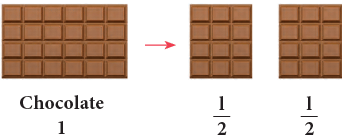
- Two equal parts are called halves.
- Each one of the equal parts is called one-half.
- One-half means 1 part out of 2 equal parts. It is written as 1 / 2.
(b) Look at the figures given alongside.
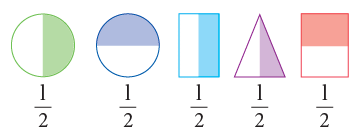 Each shape is divided into 2 equal parts.
Each shape is divided into 2 equal parts.
One part is shaded in each shape. Each shaded part represents 1 / 2.
Thirds
Three Equal Parts
(a) Rajat and Seema went to a restaurant to eat pizza with their mother. The mother ordered one pizza. She told them to share it equally. They divided it into 3 equal parts. Three equal parts are called thirds.
The mother ordered one pizza. She told them to share it equally. They divided it into 3 equal parts. Three equal parts are called thirds.
Each one of the equal parts is one-third of the whole. It is written as 1 / 3.
(b) In the picture given alongside, each shape is divided into 3 equal parts. One part out of the 3 parts is shaded. Each shaded part of the shape is one-third of the whole.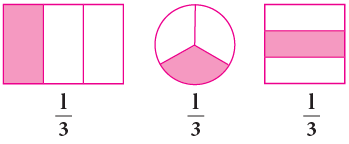
Fourths
Four Equal Parts
(a) Rajat’s mother cut the pizza into four equal parts for Rajat and his three friends.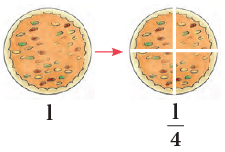 When we divide a whole into 4 equal parts we say that we divide it in fourths. Each part is one-fourth or one-quarter of the whole. This is also written as 1 / 4.
When we divide a whole into 4 equal parts we say that we divide it in fourths. Each part is one-fourth or one-quarter of the whole. This is also written as 1 / 4.
(b) Each shape, given alongside, is divided into 4 equal parts.
One out of the 4 equal parts is shaded. Each shaded part of the shape is one-fourth of the whole. Each equal part is called one-fourth.
Each equal part is called one-fourth.
One-fourth is also called as one-quarter.
One-fourth means 1 part out of 4 equal parts.
More than Four equal Part
Just as you say one-half, one-third, one-fourth and write them as 1 / 2, 1 / 3 and 1 / 4 respectively, similarly, you can name other equal parts as under:
(a) When a whole is divided into five equal parts, each part is called one-fifth.
It is written as 1 / 5.
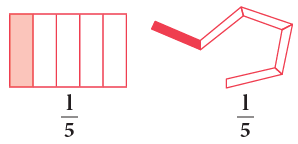 (b) When a whole is divided into six equal parts, each part is called one-sixth.
(b) When a whole is divided into six equal parts, each part is called one-sixth.
It is written as 1 / 6.
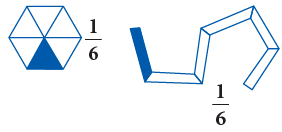 (c) When a whole is divided into seven equal parts, each part is called one-seventh. It is written as (1 / 7).
(c) When a whole is divided into seven equal parts, each part is called one-seventh. It is written as (1 / 7).
 In a similar way, you have one-eighth (1 / 8), one-ninth (1 / 9), one-tenth (1 / 10), one-eleventh (1 / 11) and so on.
In a similar way, you have one-eighth (1 / 8), one-ninth (1 / 9), one-tenth (1 / 10), one-eleventh (1 / 11) and so on.

Numerals such as 1 / 2, 1 / 3, 1 / 4, 1 / 5, etc, ... are called fractions.
Numbers named by the fractions are called fractional numbers.
More than one out of many Equal Parts
(a) In a birthday party, Aastha’s mother cut a cake into three equal parts and wanted to give one piece to Aastha. But she insisted on taking two pieces. So, Aastha got 2 out of 3 equal parts. You can express it as two-thirds or 2 / 3. (b) Bunty had a sandwich which he divided into four equal pieces as shown alongside. He ate 3 pieces out of the 4 pieces. We say, he ate three-fourths or 3 / 4 of the sandwich.
(b) Bunty had a sandwich which he divided into four equal pieces as shown alongside. He ate 3 pieces out of the 4 pieces. We say, he ate three-fourths or 3 / 4 of the sandwich.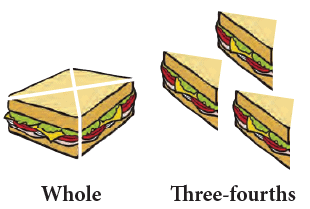 (c) The following pictures show other fractions. These will help you to understand clearly the meaning of given fractions.
(c) The following pictures show other fractions. These will help you to understand clearly the meaning of given fractions.
Fraction of a Group or a Collection
Fractions can also be used to name parts of a group or a collection.
Study the following examples.
1. 2 out of 3 balloons are green. Two-thirds of the balloons are green. The fraction for green balloons is 2 / 3. Here,
Here,
2. One out of five apples are red.
One-fifth of the apples are red. The fraction of red apples is 1 / 5.
3. 3 out of 4 animals are rabbits.
Three-fourths of the animals are rabbits. The fraction of rabbits is 3 / 4.
Numerator and Denominator
In the fraction 5 / 7, 5 is called the numerator and 7 is called the denominator.
A Fraction Represents a Division Numeral
Look at the following pictures.
a) The division numeral, 1 ÷ 5 indicates that out of 5 equal parts, 1 part is shaded.

b) The division numeral, 3 ÷ 4 indicates that 3 oranges out of 4 oranges are taken.
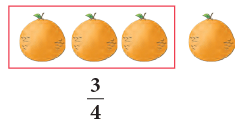
The fractions 1 / 5 and 3 / 4 also express these facts respectively.
Therefore, 1 ÷ 5 = 1 / 5 and 3 ÷ 4 = 3 / 4.
Using Division to find Fractional Part of a Whole
1. Lakshya had 8 strawberries. He ate one-half of them. How many did he eat?
To find the number of strawberries Lakshya ate, divide the strawberries, into 2 equal parts and count the number in one of these parts.
We have, 1 / 2 or 8 = 4 So, Lakshya ate 4 strawberries.
So, Lakshya ate 4 strawberries.
2. Ritu had 9 balls. She gave 1 / 3 of them to her friend. How many balls did she give away?
To find the number of balls Ritu gave to her friend, divide the balls into 3 equal groups and count the number in one of these groups.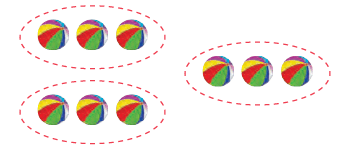 We have: 1 / 3 of 9 = 3.
We have: 1 / 3 of 9 = 3.
So, Ritu gave 3 balls to her friend.
If Ritu gave two-thirds of balls to her brother, then you need to count the balls in two groups. Two groups contain 6 balls,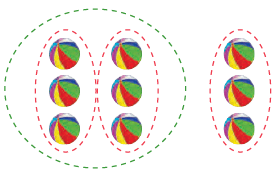 ∴ 2 / 3 of 9 = 6. Similarly, to find 1 / 2 of 6 pencils, you divide the 6 pencils into 2 groups and count the number of pencils in 1 group, which is 3 pencils.
∴ 2 / 3 of 9 = 6. Similarly, to find 1 / 2 of 6 pencils, you divide the 6 pencils into 2 groups and count the number of pencils in 1 group, which is 3 pencils.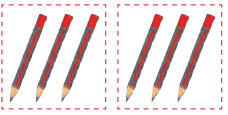 ∴ 1 / 2 of 6 = 3.
∴ 1 / 2 of 6 = 3.
To find 2 / 3 of 6 pencils, you count the number of pencils in 2 groups out of 3 groups. This is four pencils. ∴ 2 / 3 of 6 = 4.
∴ 2 / 3 of 6 = 4. You can also find 2 / 3 of 9 as shown below.
You can also find 2 / 3 of 9 as shown below.
2 / 3 of 9 = 2 × (9 ÷ 3) = 2 × 3 = 6
You can also write 2 / 3 of 9 as under:
2 / 3 of 9 = (2 × 9) ÷ 3 = 18 ÷ 3 = 6
Example: Ria had 14 crayons in a packet. She gave one-half to her friend. How many crayons did she give to her friend?
One-half of
Thus, Ria gave 7 crayons to her friend.
Fraction on the Number Line
As numbers are represented on a number line, fractions can also be shown on a number line.
- Each fraction number line starts at 0 and ends in 1.
- The denominator of the fraction decides into how many equal parts we divide the whole number line from 0 to 1.
- The numerator of the fraction decides how many of these equal parts we take.
For example: To represent 1 / 2, we divide the number line into two equal parts and take one part out of those.
To represent 1 / 2, we divide the number line into two equal parts and take one part out of those.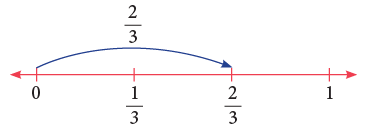 To represent 2 / 3, we divide the number line into three equal parts and take two parts out of those.
To represent 2 / 3, we divide the number line into three equal parts and take two parts out of those. To represent 3 / 4, we divide the number line into four equal parts and take three parts out of those.
To represent 3 / 4, we divide the number line into four equal parts and take three parts out of those.
Now, look at the number line and write the fractions represented by the points A and B. A represents 2 / 5 and B represents 4 / 5 on the number line.
A represents 2 / 5 and B represents 4 / 5 on the number line.
|
37 videos|72 docs|49 tests
|
FAQs on Fractions Class 3 Notes Maths
| 1. What are fractions and how are they represented? |  |
| 2. How do you divide a fraction by a whole number? |  |
| 3. What is the significance of fractions on a number line? |  |
| 4. How can fractions represent a division numeral? |  |
| 5. What does it mean to have more than four equal parts in a fraction? |  |

















